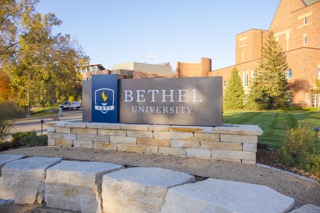On Sept. 16, 2024, Bethel University announced that the institution would lower tuition by roughly $18,000, a 41% cut. The move is designed to bring “transparency and clarity around the true price of attending Bethel,” according to a statement released by the university.
The decision will be implemented starting in the 2025-2026 academic year and will be applied to all students attending or entering the university after that date.
“I wasn’t really surprised; [tuition] needed to be reduced,” Canon Dyer, a Bethel senior, said. “The price tag was a bit of a misnomer,” referring to the difference between stated tuition and what he paid after scholarships.
Paul McGinnis, vice president of enrollment and marketing for Bethel, explained the tuition cut as a way for families considering college education to more clearly see the true cost of attendance.
“This was a really researched and data-driven decision,” McGinnis said. “What really prompted it is the confusion and frustration of families going through the admissions process just got to such a height that [we were] saying we got to do something different.”
He added: “This is probably the biggest investment that most of these families have made outside of a house, and it involves their most precious treasure, which is their kids, and yet we in higher-ed are making it confusing with this really high price that nobody pays and then a high aid strategy.”
Many students have expressed support for the decision, noting that the new price tag simplifies the apparent cost of attending.
“I think it’s great…the face value is changing,” Ken Kueber, a Bethel senior, said. “I’m the first person [in my family] to go to college, and that was one thing we were not sure about, applying to these schools that have a high sticker price, but then further realizing that I’m not actually paying that because I have so much financial aid.”
Within the last decade, Bethel has been forced to make cuts to its programs and faculty after serious budget shortfalls. A large part of the college’s financial issues stemmed from declining enrollment before 2022.
Some members of the Bethel community consider the tuition cut part of a larger effort toward increasing enrollment and the college’s bottom line.
“The average attendance is expected to rise by 34 students,” Daniel Carlson, a Bethel senior, said. “And if every student’s paying $30,000 a year, that’s pretty healthy for a bottom line, right?”
McGinnis disputes Carlson’s claim that the decision was financial, instead saying that the tuition cut originates from Bethel’s institutional values.
“The number one reason was more missional than anything,” McGinnis said. “[Cutting tuition] could grow enrollment. Sometimes it grows enrollment, sometimes it doesn’t … the data proves that.”
Patricia Langer, Macalester’s vice president of administration and finance, sees the move as a way for Bethel to advertise itself, but stressed that the cost of college attendance would not be reduced for Bethel students receiving scholarships.
“What I think is the most important for everyone to understand, particularly for students to understand, is that dramatic changes in tuition pricing are a way to restate price, but they do not change the cost of the education for most families,” Langer said. “And, generally, the families that do experience a cost reduction are at the higher end of the income scale.”
Langer also believes that Bethel will eventually reverse its decision. She remarked: “I have seen some … institutions that we consider our peers make this choice, and everyone that has ever done it has reversed it within two or three years because it doesn’t achieve what they’re hoping it will achieve.”
Macalester relies on a high-tuition/ high-discount model, where a high “sticker price” is frequently offset by large amounts of financial aid in the forms of merit and needs-based scholarships. “Our goal is to make Macalester as affordable as we can to all students,” Langer said. “[Bethel’s] model makes an institution less expensive for higher income families, and that’s not who we are.” Among other concerns for Macalester is that the college’s prestige would be lowered if it were to reduce the price to a point below peer schools. Langer emphasized that the effects of a cut could be detrimental to a college in the long term. “There is likely a spike of applications and students that come to your school and then there’s likely a fall off once the reality of the change is experienced by families and students applying, and then you’re sitting in a different peer group and you’ve lost your place in a peer group and for nothing,” Langer said. “That’s the hardest part for me.”
McGinnis, however, believes that the high-tuition, high-discount model forms a barrier to higher education that peer colleges should work to break down.
“There are so many underrepresented groups of students and first-gen students that don’t know the gain, that look at a sticker price, and they don’t even consider Macalester or Bethel because of that, and they don’t know that you’re going to pay 30%, half of that,” McGinnis said. “And so if our mission is to educate, impact and equip students to go change the world and go make an impact, but they don’t even think it’s a possibility for them, there’s an obligation that we have to make that right.
“What we’re doing from a marketing perspective is making sure that we’re continuing to build the value of Bethel, because the value of Bethel hasn’t changed. It’s just now there’s not this huge gap in fake sticker price.”
Matté Lopez ’25, co-founder and lead organizer for Macalester’s First-Generation Low-Income Student Union, argues that many of the lowest-income students know about the financial pricing scheme found at Macalester and many other institutions.
“For someone like me, like the lowest-income student, I don’t really care, because I’m still not going to pay that much anyway,” Lopez said. “If they’re giving me a lot of money and so if you cut it from 60k to 40k, what does that do for me?
“I think the parents and the people that are supporting the majority of Macalester students … know how college works, and they know that there are financial aid calculators to use. They’ve sent other children to college. Their friends have sent other children to college, and they know that there are scholarships. So I don’t think this is like some big revelation for Macalester families.”
Joel Sadofsky ’25, president of Macalester College Student Government, shares a similar sentiment and believes that Macalester’s prestige works well with the high-tuition/high-discount model.
“I think the reason this model works for Mac, as I understand it, is because we have this appeal and this level of status and respect and desirability as a school,” Sadofsky said. “It makes it so there are people … who are going to go here. They’re going to pay the ticket price to go here, and there are enough of them that it continues to be a viable model of financing the college and prioritizing financial aid.”
Colleges like Bethel are threatened by an upcoming decline in the number of incoming college students and a lack of confidence in higher education. Sadofsky, however, thinks that Macalester is in a stable position.
“Macalester obviously could be in a better financial situation and will be in a worse financial situation as a result of this demographic shift,” Sadofsky said. “However, we have the appeal to be mostly insulated from it, and we’re less worried about doing these sort of drastic changes to keep enrollment up.”












